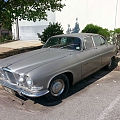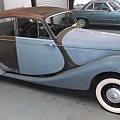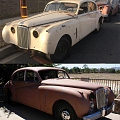Address:1280 N Main St Fuquay Varina NC 27526
Shop Phone: (919) 552-9615
Jaguar Mark X
TheJaguar Mark X(Mark ten) was the top-of-the-rangesalooncar built by the British manufacturerJaguar primarily aimed at the United States market. The Mark X succeeded theMark IXas the company's largest saloon model. Body: The unitary construction body-shell was codenamed "Zenith" during development and this floor pan continued in production long after Mark X production ended as the DS 420 Limousine. The new style four headlamps set into rounded front fenders with a vaned grill first appeared on the Mark X. The interior was the last Jaguar with abundant standard woodwork including the dashboard escutcheons window trim a pair of large bookmatched fold out rear picnic tables and a front seat pull-out picnic table stowed beneath the instrument cluster. Later air conditioning and a sound-proof glass division between the front and rear seats were added as options. From its introduction until the arrival in 1992 of the low-slungXJ220 the Mark X stood as one of the widest production Jaguars ever built.Asked in 1972 if he thought the Mark X had grown rather too large Jaguar chairmanWilliam Lyons agreed that it "definitely" had: he opined that the then recently introduced and notably more compactJaguar XJ6was by contrast an "ideal size".[5] The substantial doors required helicaltorsion springsinside the door pillars to enable them to be opened from the inside with an acceptably low level of effort. Mechanical: The Mark X was the first Jaguar saloon to featureindependent rear suspension. It differed from earlier large Jaguar saloons in having 14" wheels instead of the more common 15". It used a wider-track version ofJaguar's IRS unitfirst seen on theE Type which was subsequently used on Jaguar vehicles untilXJ-Sproduction ended in 1996. Front suspension used double wishbones with coil springs and telescopic dampers. The car initially featured a 3781cc version of Jaguar'sXKin-line six-cylinder engine. A 9:1 compression ratio was standard but an alternative 8:1 compression ratio was available as an option. For theLondon Motor Showin October 1964 the enlarged 4235cc unit took over although the 3.8-litre unit could still be specified until October 1965. TripleSU carburetorswere fitted fed from an AC Delco air filter mounted ahead of the right hand front wheel. Transmission options weremanual manual withoverdrive automatic or automatic with overdrive. The arrival of the 4.2-litre power unit coincided with the introduction of a newly developed all-synchromesh four-speed gear box replacing the venerable box inherited by the 3.8-litre Mark X from theMark IXwhich had featured synchromesh only on the top three ratios. Many domestic market cars and almost all cars destined for the important North American markets left the factory with a Borg Warnerautomatic gear-box. The 4.2-litre engine's introduction was also marked by a transmission upgrade for buyers of the automatic cars who saw the Borg Warner transmission system switched from a DG to a Typ-8 unit. The power train was completed by a Thornton Powr-Lok limited-slip differential. Stopping power for this heavy car came from power-assisted disc-brakes on all four wheels. Power-assisted steering was standard the later 4.2 cars receiving Marles Varamatic Bendix (Adwest) variable ratio steering boxes designed by an Australian Arthur Bishop.Jaguar Mark X
Overview
Manufacturer
Jaguar Cars
Production
1961–1970 13382 3.8 Litre 5137 4.2 Litre 5763 420G
Assembly
CoventryEngland
Body and chassis
Class
Full-sizeluxury car
Bodystyle
4-doorsaloon
Layout
FR layout
Related
Daimler DS420
Powertrain
Engine
3781 ccXKI6to 1964 4235 ccXKI6
Dimensions
Wheelbase
120in (3000mm)[1]
Length
202in (5100mm)
Width
76.3 in(1938 mm)[2]
Height
54.5in (1380mm)
Curbweight
4200lb (1900kg)
Chronology
Predecessor
Jaguar Mark IX
Successor
Jaguar XJ6
 NO RESERVE!! 1964 Jaguar Mark X 3.8L Saloon - 35,000 One-Family Miles!! RARE!!!!
NO RESERVE!! 1964 Jaguar Mark X 3.8L Saloon - 35,000 One-Family Miles!! RARE!!!!
 1949 JAGUAR MKV BARN FIND SURVIVOR MARK 5 1949 JAGUAR SALOON 48 50 51 52
1949 JAGUAR MKV BARN FIND SURVIVOR MARK 5 1949 JAGUAR SALOON 48 50 51 52
 66 Jaguar Mark X 420G 4.2 10 Sedan Rare Jag 420 Big Body Saloon Straight 6 Video
66 Jaguar Mark X 420G 4.2 10 Sedan Rare Jag 420 Big Body Saloon Straight 6 Video
 1952 Jaguar Mark 7 & 1954 Jaguar MK VII Saloon (2 Jags For Sale)
1952 Jaguar Mark 7 & 1954 Jaguar MK VII Saloon (2 Jags For Sale)